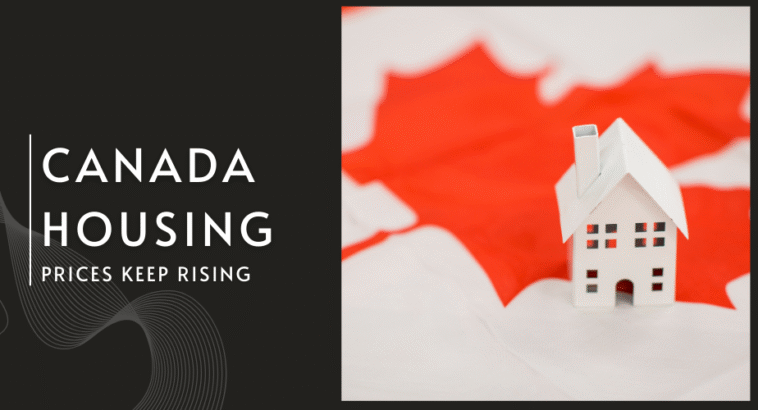Canada’s housing landscape has captured global attention due to its relentless price surge. Despite government interventions and rising interest rates, the housing sector shows no signs of cooling off. In this in-depth article, we explore the critical factors influencing the ongoing rise in Canada housing prices, supported by economic data, market trends, and long-term projections. Whether you’re a homeowner, buyer, investor, or policymaker, understanding these dynamics is essential.
Population Growth and Immigration Fueling Demand
Canada’s Immigration Policies and Urban Pressure
Canada’s welcoming immigration policy has significantly increased its population, especially in urban centers like Toronto, Vancouver, and Montreal. This influx puts tremendous pressure on the housing market, where supply struggles to keep pace with demand.
Urban Concentration and Limited Space
Most immigrants settle in urban areas, driving up prices due to land scarcity and high demand. This results in fierce competition for limited housing, escalating the cost of both ownership and rent.
Demographics and Household Formation
Younger generations forming new households also contribute to rising demand. With more people entering the housing market in Canada, supply constraints become more acute, pushing prices further.
Chronic Housing Supply Shortages
Zoning Laws and Construction Bottlenecks
One of the most persistent issues in housing is the slow pace of new housing development. Municipal zoning restrictions and bureaucratic red tape delay projects, preventing the market from meeting demand.
Labour and Material Shortages
New home completions are being further slowed down by the construction industry’s struggles with a lack of experienced workers and high building material costs. This creates a seller’s market by raising the value of existing homes.
Inefficient Land Use Policies
Inefficient land use and policies that restrict high-density development in key areas mean that new housing supply can’t keep up, reinforcing a tight housing market.
Low Interest Rates and Easy Credit History
Historic Low Interest Rate Environment
For over a decade, Canada experienced historically low interest rates, making borrowing cheaper and mortgages more accessible. This spurred home buying, increasing competition and prices.
Access to Credit and Speculative Buying
Easier access to credit encouraged speculative investments. Investors bought multiple properties, confident in rising values. This intensified demand within the housing market Canada.
Interest Rate Sensitivity
Even with recent rate hikes, many Canadians are locked into low-interest mortgages, reducing urgency to sell. This limits market supply while maintaining upward pressure on prices.
Investor Activity and Foreign Ownership
Real Estate as an Investment Vehicle
Real estate is seen as a stable investment. In Canada, this perception has fueled a surge in investor-owned properties, particularly condos, in major urban areas.
Foreign Buyers and Capital Inflows
Foreign investment, especially from countries like China, has historically driven up prices in cities like Vancouver. Despite recent restrictions, the Canada housing market still feels these effects.
Impact on First-Time Buyers
Investor competition makes it harder for first-time buyers to enter the housing scene. This has long-term implications for wealth inequality and generational homeownership rates.
Government Policies and Incentives
Housing Benefit and Affordability Programs
Programs like the Canada housing benefit aim to support low-income renters, but they don’t directly impact the supply of affordable homes. While helpful, they often fall short in addressing price inflation.
Mortgage Stress Tests and Their Impact
The introduction of mortgage stress tests was intended to cool demand, but in high-demand markets, their effectiveness has been limited.
Property Transfer Taxes and Incentives
Some provinces introduced taxes on foreign buyers and vacant homes, yet prices continue to rise, showing that deeper structural changes are needed in the housing market.
Economic Growth and Wage Trends
GDP Growth and Regional Economic Disparities
Canada’s economic growth, particularly in urban centers, has increased incomes and purchasing power. However, wage increases haven’t kept pace with housing price growth.
Job Creation in Urban Hubs
High-paying jobs in tech, finance, and healthcare have concentrated in cities, attracting more workers and inflating local housing prices due to demand outstripping supply.
Wealth Accumulation Through Real Estate
Many Canadians see homeownership as the main path to wealth accumulation. This mindset reinforces demand and encourages early market entry, sustaining high prices.
Inflation and Construction Costs
Impact of General Inflation
Overall inflation has led to higher costs for goods, labor, and services, including those involved in homebuilding. This translates into more expensive homes.
Rising Costs of Building Materials
Lumber, steel, and other materials have surged in price due to global supply chain issues. This directly impacts new home pricing in the housing market.
Limited Incentives for Developers
High costs and risk-averse policies mean developers are cautious about launching new projects, particularly in the affordable housing segment, worsening the supply-demand imbalance.
Speculation, Fear of Missing Out (FOMO), and Market Psychology
Behavioral Economics and FOMO
Homebuyers often act out of fear of missing out, especially when prices consistently rise. This emotional decision-making inflates the housing market Canada artificially.
Media Influence and Public Perception
The media is crucial in generating urgency and magnifying price patterns. Speculative activity is encouraged by headlines about bidding wars and price explosions.
Homeownership as a Cultural Value
Culturally, owning a home is seen as a milestone in Canada. This societal pressure drives people into the housing market sooner than they may be financially prepared.
Regional Variations in Housing Price Trends
Hot Markets vs. Cooling Regions
While cities like Toronto and Vancouver remain red-hot, smaller markets like Regina or Moncton are seeing slower growth, showing a regional divide in the housing market.
Remote Work and Migration Patterns
The rise of remote work during the pandemic led many to seek homes outside major urban centers. This drove up prices in previously affordable areas.
Infrastructure and Transit Development
Regional housing patterns are shaped by investments in public transportation and other infrastructure developments, which frequently raise property values in the surrounding communities.
What Lies Ahead for Housing?
Forecasting the Next 5–10 Years
Most analysts predict continued price increases, albeit at a slower pace. Supply constraints, economic growth, and persistent demand will likely support high valuations.
Policy Reforms on the Horizon
Governments are increasingly pressured to implement meaningful reforms—like incentivizing density, cutting red tape, and investing in public housing—to stabilize the housing market.
Strategic Advice for Buyers and Investors
Buyers should be strategic, patient, and informed. Understanding macroeconomic trends and being financially prepared is key to navigating the complex housing landscape.
Conclusion: Understanding the Big Picture in Canada Housing
The sustained rise in housing prices is driven by a confluence of powerful forces: population growth, limited supply, economic strength, and market psychology. While policymakers scramble for solutions, the housing market continues to evolve. Understanding these deep-rooted dynamics is essential for anyone navigating the housing market, whether you’re investing, buying your first home, or considering relocation.




